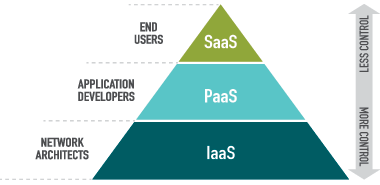When migrating to a cloud environment, there are multiple types of service to consider, with each offering its own range of benefits. In this article we’ve delved into PaaS (Platform as a Service) and how it works.
An introduction to PaaS
Platform as a Service (PaaS) is best visualised as sitting in the middle of a three-tier cloud computing pyramid that also comprises IaaS (Infrastructure as a Service) and SaaS (Software as a Service).
The amount of customer control over the virtualised IT resources increases as you descend the pyramid.
How does PaaS work?
When it comes to how PaaS works, think of it as an environment that facilitates application development and deployment. Service providers (such as AWS or Azure) provision and manage not just the fundamental infrastructure resources, but also the operating systems, databases, middleware and software tools that overlay the hardware.
Customers, freed from having to create and maintain the environment – which is hosted and managed by a provider – can focus on their work within it, such as developing, testing, deploying and hosting applications.
The evolution of PaaS
The most significant shift in PaaS has been its evolution from ‘developers’ dream’, where coders could just crunch away without having to worry about any of the complex and challenging IT plumbing, to today’s core business platform.
PaaS cloud computing is now increasingly being leveraged for full application lifecycle management; so no longer just the traditional build and test phase, but also the ongoing delivery and support of applications to the end user.
Real-world PaaS examples and case uses
Due to Platform as a Service effectively being a ready-made, cloud-based environment for developers to build and deploy applications (without the hassle of having to manage and monitor the software), there are numerous real-world PaaS examples – across a whole range of industries. A few examples include:
- E-commerce: Rather than having to build and manage a virtual backend, many e-commerce businesses instead take advantage of PaaS. With the infrastructural building blocks in place, owners can immediately begin introducing product listings, establishing payment processors, and handling orders.
- Finance: PaaS is often used by financial institutions and banks to deliver effective online banking and trading. And because they don’t need to spend time managing the platforms, they’re able to allocate increased resources to security and fraud detection.
- Healthcare: PaaS is instrumental in developing patient access portals, where users can request appointments and manage prescriptions. Healthcare providers and businesses in the sector can also dedicate more time and resources to managing health records, which ultimately improves patient care and outcomes.
- Entertainment: Many businesses within the entertainment industry rely on PaaS cloud computing, to deliver streaming platforms, online gaming, and media distribution. Using PaaS ensures businesses are quick-to-market, which is essential in media where trends often change.
The benefits of PAAS
We’ve looked at what platform as a service is, and the common real-world use cases. But what are the main benefits of PaaS for businesses?
- Replaces lower-level infrastructure components and maintenance requirement: It’s a time, cost, and resource-effective means of running application development environments
- No CAPEX required: Greater affordability encourages a more responsive approach
- Front-end focus: Development teams can concentrate on the application, rather than the ‘plumbing’
- Flexibility and adaptability: Platforms can be quickly tailored and scaled to meet precise demands
- Diverse availability: Multiple developers can collaborate on builds effortlessly, regardless of location
- End-to-end lifecycle management: Streamlined, efficient and controlled means to develop and deploy applications
- Shorter development cycles: Ready-made environments boost time-to-market and increase revenue
- Specialist provision: Expert design, delivery, and on-going management guarantees a highly secure and fully optimised environment
Why should organisations consider PaaS?
With its ability to offer scalable, streamlined and fully managed development environments of almost infinite capacity, as well as its characteristic OpEx-based pricing model, PaaS can:
- Significantly reduce the total cost of ownership, with massive savings on infrastructure and software maintenance costs
- Underpin agile software development, speeding time to market and revenue
- Deliver the same experience and performance regardless of load and usage
- Facilitate effective collaboration of distributed development teams
- Enhance platform management through the easy, frequent upgrading of operating systems
- Encourage greater responsiveness to change and opportunity, through removal of CAPEX barriers
- Promote more confident, quality development by providing a robust, predictable and integrated environment
- Support core competency approach, with developers allowed to focus on what they do best
- Safeguard builds, delivery capability and intellectual property, with data security, backup and recovery all part of the service wrap
Are there any drawbacks of PaaS?
Of course, while there are great PaaS examples above, and many reasons to choose Platform as a Service, it’s also important to have an idea of the potential drawbacks – after all, you never know, an alternative service model like SaaS or IaaS might be more appropriate for your business!
With that in mind, a few considerations you should make before investing in PaaS cloud computing include:
- Limited control: A trade off of PaaS is that you don’t have quite as much control over your environment as if you choose IaaS (for example), which lets you manage your complete infrastructure. With this in mind, your ready-made cloud environment might feel a little restrictive if you have specific or niche architectural requirements.
- Vendor lock in: When operating within a public cloud environment, where a provider manages your infrastructure, there’s always the risk that you may begin to rely on the vendor – which can lead to lock in and make it trickier to switch to another platform in future. However, if you bear this in mind from the start, you can ensure you don’t become overly-reliant.
- Provider dependency: While conceding responsibility for managing your infrastructure is one of the great benefits of PaaS, it does make you dependent on your provider’s services, which, in extreme cases, can have an impact on your business.
Hopefully, you now feel completely clued up on PaaS and its role in cloud computing! Though, of course, if you have any further questions, don’t hesitate to get in touch with our team of expert cloud consultants. Alternatively, discover even more useful insight from our team over on our blog – including our article comparing PaaS vs SaaS vs IaaS.




